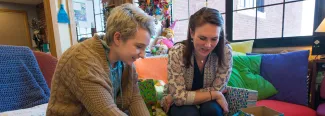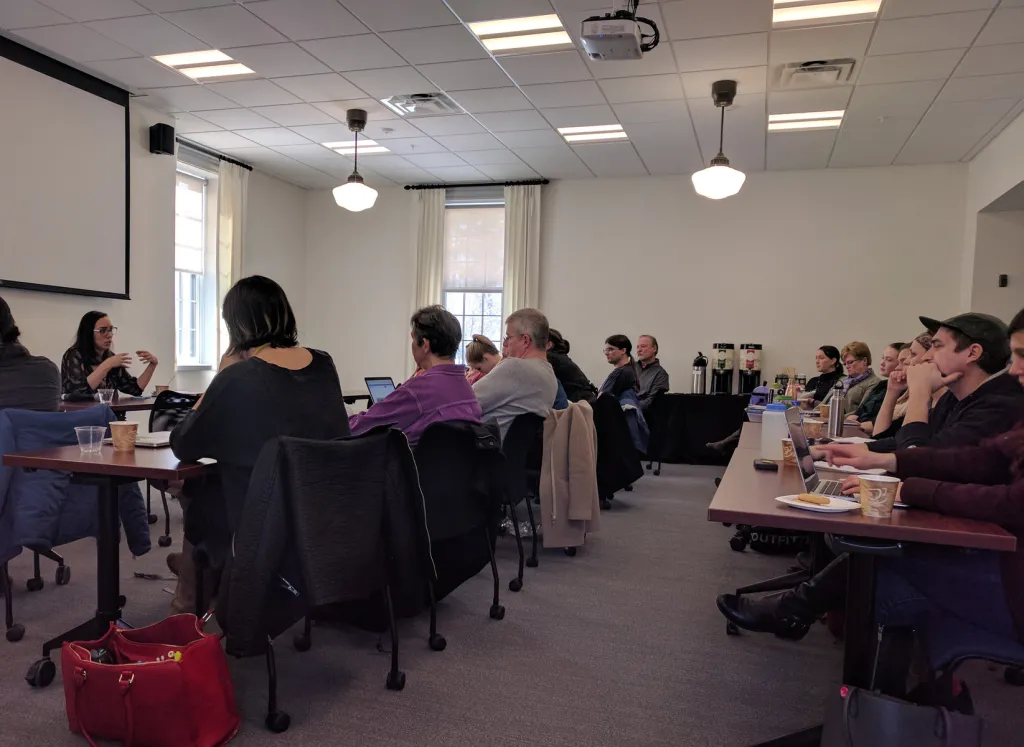
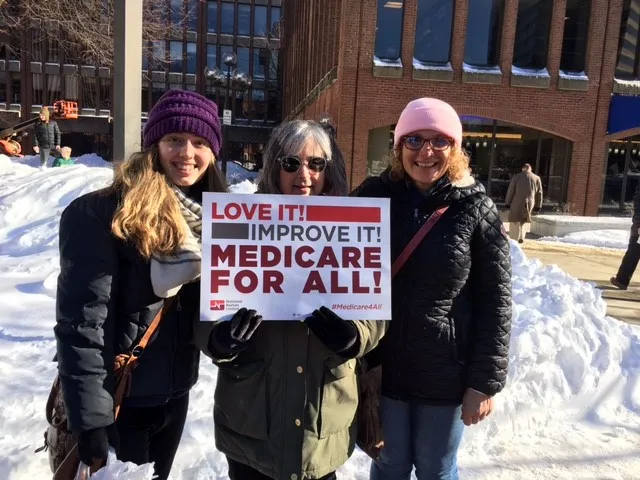
On a sparklingly cold St. Patrick’s Day, I found myself in front of Senator Susan Collins’ office having a conversation with a perfect stranger. He was about my age and like me, was carrying a placard. Mine was a hand-me-down sign brandishing support for Medicare; his was backing Planned Parenthood. “It’s been a while since I’ve held a sign protesting anything,” I said. “Me, too,” he responded. He pointed to the time-worn wooden handle that held his sign. “That’s my youngest son’s hockey stick. He’s graduating from college this spring.”
We stood enjoying the sun and solidarity that had brought us together to voice opposition to the proposed American Health Care Act, the initiative developed by congressional Republicans and insurance lobbyists to repeal and replace the ACA. The small gathering of people was chatty; passersby either nodded acknowledgement or ignored us. As the group began to disperse the stranger turned to me and said, “I felt like I had no choice but to get back to the rallies and protests.”
I felt similarly, though my urgency was underscored by social work values and identity. My choice was not whether to be an agent of change but whether, as Marie Louise Kondrat, a critical social work theorist would say, “to be a more conscious agent of change”1 (Kondrat, 1999)
These musings are most appropriate given the fact that March commemorates Social Work Month. The 2017 campaign slogan is Social Workers Stand Up, a theme aimed at raising public awareness about the many and significant ways social workers contribute to individuals and society (see below).
This issue of SSW News celebrates Social Work Month with our own theme — Voice and Choice. Throughout the pages, you’ll learn about ways in which UNE SSW students, faculty, alumni, friends and stakeholders have used their voices and choices in daily interactions with clients and colleagues and in work with social structures, communities and policies. Their individual stories come together to form a cohesive narrative — one that reminds us that social workers are by necessity committed to social change and advocacy. The choice is now — proclaim your intention to become a conscious and conscientious agent of change and join the conversation with social workers across the globe to:
- Work in all areas of our society to improve participation, health and prosperity
- Ensure equal rights for all
- Advocate for legislation and policies including renewal of the Voting Rights Act, The Violence Against Women Act, The Civil Rights Act, the Affordable Care Act, Medicaid, unemployment insurance, workplace safety and Social Security benefits
- Work with people to overcome substance use disorders, chronic health conditions and mental illnesses
- Help with disaster relief to help people and communities return to peace and prosperity
Shelley
1Kondrat, M. E. (1999). “Who is the “self” in self-aware: Professional self-awareness from a critical theory perspective’. Social Services Review, December, pp. 451-75.
In this Issue
News and Happenings
- Shalom House Art Exhibit Opening!
- Two new videos about UNE SSW alumni!
- International Service Learning in Jamaica
- ‘Flying a Sign' is an Exercise in Humility: article published by Katy Finch
- Hot Dog and Dialogue: op-ed published by Thomas C. McLaughlin
- Finding One's True Voice in the Most Challenging of Times: op-ed published by Shelley Cohen Konrad
- We Need to Support the most Vulnerable in our State: op-ed published by Frank Brooks
- We are All Immigrants: op-ed published by Thomas C. McLaughlin
- Immigrants Made America Great: op-ed published by Cyndi Amato
- The Shared Spaces of Ernest and Mike: article published by Megan Webster and Thomas C. McLaughlin
- Faculty Appointments and Promotions
- Visiting Faculty from Finland talks to Research Class
- Shelley Cohen Konrad presents at the Morrison Center
- UNE SSW's new Twitter account!
Our Voices, Our Choices
- The Spirit of Awakening — by Karen Distefano
- Hafa Adai! Visiting Guam and the Mariana Islands — by Arabella Perez
- News from the Maine NASW Chapter — by Lori K. Gramlich
- Exploring Shared Spaces and Common Ground — by Megan Webster and Thomas C. McLaughlin
- Social Justice Advocacy Group Forum — ILAP Event
- Who is Your Social Work Hero?
Opportunities & Information
- Social Justice Advocacy Forum Introduction
- Alumni Survey
- Submit a Performance Piece for a AASJ event!
- UNE Honors Society
- SSW Student Organization
- Call for Social Justice Artwork
- Call for Alumni: Field Instructors Needed!
Upcoming Events
News and Happenings
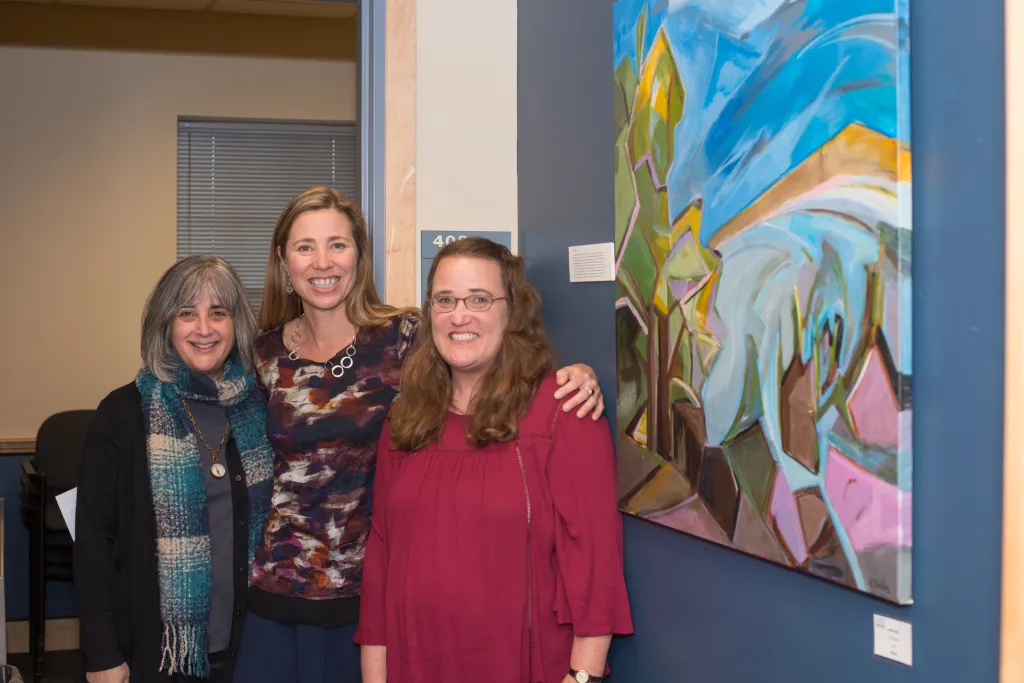
Shalom House Art Exhibit Opening
Thank you everyone for coming out to the opening in February of the "Artists of Shalom House" exhibit. The show has been a marvelous success and thank you to those who have stopped by to view the art work that is up on the fourth floor of Hersey Hall. The work will be up through the month of April. For more info on the Shalom House and their wonderful Art Program please check out their website!
UNE PRODUCED TWO GREAT VIDEOS HIGHLIGHTING ALUMNI!
Video highlighting Caroline 'Tookie' Bright ('10) where she discusses how her work as a youth and family services counselor enhances the wellbeing of families, individuals and communities using the training she received at UNE.
Video highlighting Charlotte Warren ('08) and her work as a representative in the Maine State Legislature
INTERNATIONAL SERVICE LEARNING IN JAMAICA
See what UNE MSW students have been up to during their journey to Jamaica in January!
FOR THOSE STANDING ON THE MEDIAN, ‘FLYING A SIGN’ IS AN EXERCISE IN HUMILITY — PPH ARTICLE BY MSW STUDENT KATY FINCH
For three days in early January, with camera and microphone in hand, we embarked on a project to document people’s experiences of standing on the median or along the street with cardboard signs. The practice, which is called “flying a sign,” is an issue of intense debate in Portland and beyond. We wanted to know what motivated people to fly signs, what they used the money for and what they did on a day-to-day basis to survive. We interviewed 10 people, and here is what we learned...
HOT DOG AND DIALOG: SOCIAL WORKER TURNED HOT DOG VENDOR — PHOENIX ARTICLE BY PROFESSOR THOMAS MCLAUGHLIN
Article talking to and about Mark Gatti of Mark's Hot Dogs, a fixture of the Portland Old Port for 34 years.
MAINE VOICES: FINDING ONE’S TRUE VOICE IN THE MOST CHALLENGING OF TIMES — PPH ARTICLE BY PROFESSOR AND DIRECTOR SHELLEY COHEN KONRAD
Banning refugees and immigrants brings back the worst — and best — of episodes from our history.
WE NEED TO SUPPORT THE MOST VULNERABLE PEOPLE IN OUR STATE — PPH ARTICLE BY PROFESSOR FRANK BROOKS
An important program is targeted for severe cuts in reimbursement as a result of DHHS reviews.
WE ARE ALL IMMIGRANTS, AND WE ALL HAVE STORIES TO TELL — BDN OP-ED BY PROFESSOR THOMAS MCLAUGHLIN
I must confess, I don’t like attending rallies. Perhaps it comes from too many years of policing them or maybe because I haven’t really seen how rallies, protests and marches make a difference. They all seem to follow the same formula: chanting, impassioned speeches, more chanting, then some call to action. It’s the action part that never seems to happen. If it does happen, it doesn’t carry the weight or force of the rally. It seems disconnected. But in the last two weeks something has changed...
MAINE VOICES: IMMIGRANTS MADE AMERICA GREAT — PPH ARTICLE BY PROFESSOR CYNDI AMATO
The story of America is only the story of new arrivals arriving, striving and becoming Americans in their own ways...
THE SHARED SPACES OF ERNEST AND MIKE: PHOENIX COVER STORY BY STUDENT SUPPORT SPECIALIST MEG WEBSTER AND PROFESSOR THOMAS MCLAUGHLIN
When two people physically occupy a shared space in shared time, does it strengthen their commonality? Does the culture and community of Portland foster commonality?...
CONGRATULATIONS TO SOME OF OUR AMAZING FACULTY: APPOINTMENTS AND PROMOTIONS!
- Amy Coha – Clinical Professor, reappointment and promotion
- Craig Owens – Assistant Clinical Professor, reappointment
- Wanda Anderson — Clinical Professor, reappointment and promotion
- Amy Storch — Senior Lecturer, reappointment and promotion
- Mary White — Associate Clinical Professor, reappointment and promotion
Best wishes to you all on work well done!
VISITING FACULTY FROM FINLAND DISCUSSES SOCIAL WELFARE IN FINLAND AND EUROPE WITH RESEARCH STUDENTS
Dr. Timo Toikko, a principal lecturer and Master of Social Worlk program coordinator from the Seinajoki University of Applied Sciences in Seinajoki, Finland, stopped by Tom's research class this month to talk to students about the systems of social welfare in Finland and Europe. Timo has been working closely with Tom over the past 10 years on several projects including an analysis of youth confidence in the social welfare system or the welfare state. The two of them, along with another colleague, Teemu Rantanen from Larea University of Applied sciences in Finland, published a paper on confidence and attitudes toward welfare and poverty. Also, Timo and Teemu have just published the findings of another study about the welfare state model, political attitudes and attitudes toward poverty. Here is a link to that article.
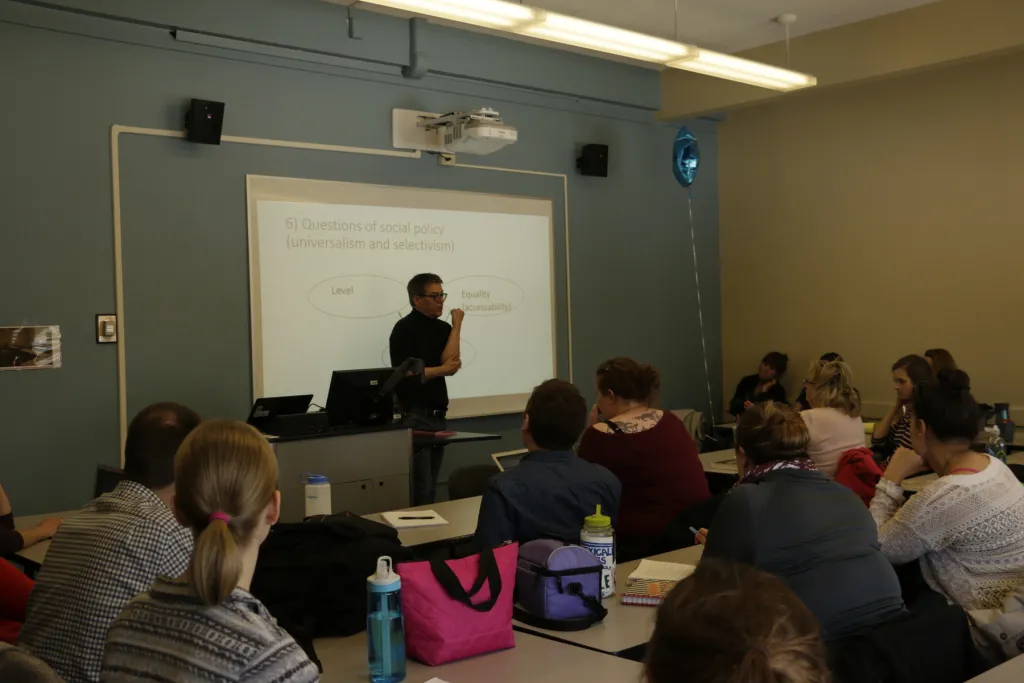
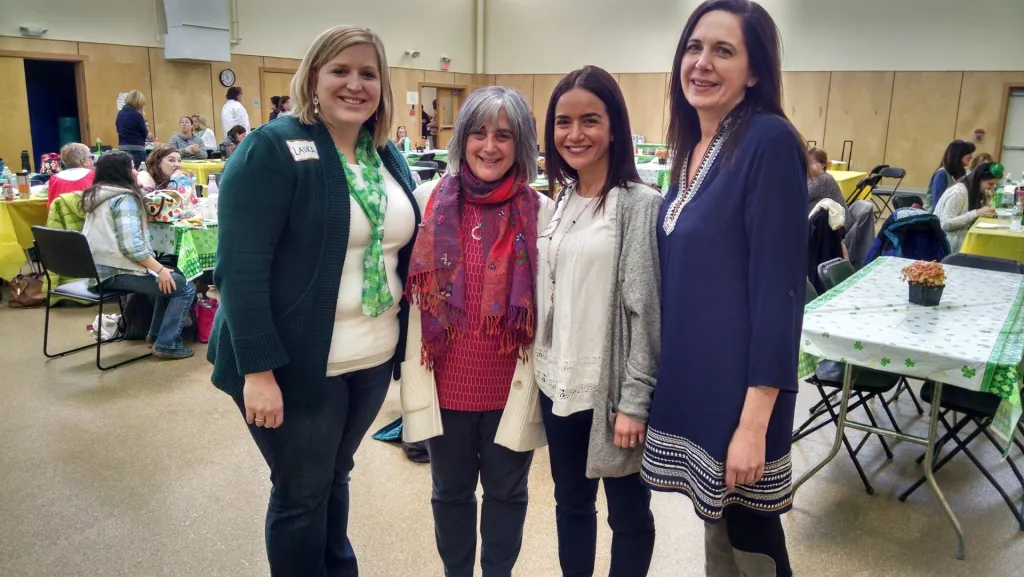
SHELLEY COHEN KONDRAD PRESENTS AT THE MORRISON CENTER
Shelley was pleased to present 'Unexpected Lives' at the Morrison Center, focusing on grief and loss related to parenting and caring for children with disabilities and life-affecting illnesses. With her at the presentation were alumni Laura Prime ('09), Michelle Scontracs Dupuis ('09), and Sara Filliettaz ('02) who are all social workers at the Morrison Center.
the spirit of awakening
THE SPIRIT OF AWAKENING
By Karen Distefano
Karen Distefano (MSW Candidate '19) is a student in our online program. A former Marine reservist and current mother to three teenage boys, she has been in Massachusetts for more than 10 years, and currently works with district schools to promote community engagement, support and resources to families at risk.
As a mother of three teenage boys, educator and therapeutic foster parent, I have considered myself an advocate for more than thirty years. Last July, I went for a job interview that changed my life. Why was I applying for a teaching position when everything I have done seemed more like a clinician? My first “ah-ha” moment. Two weeks later, I applied to the UNE Graduate School of Social Work as a distance learner. Since that day, my moments of awakening are too numerous to count.
I am busy, and I have been involved in PTO, coaching and teaching religion to seventh graders. I was already doing more than anyone I knew, and was proud of my foster work. But Policy humbled me. I realized how little I knew about the battles that are being fought every day in this country, and how our fate is interwoven with communities around the world. I work as our town coordinator for the Coordinated Family and Community Engagement Grant that is funded by the MA Department of Early Education and Care. The CFCE promotes literacy to young children and their caregivers. Recently, when I was asked to join other CFCEs on Advocacy Day at the Boston State House, I hesitated for a moment, but Policy taught me that I, as a social worker, need to be part of the policy making and the voice of those who are unable to be heard. I said “yes,” and brought my co-worker with me. It was an honor to be surrounded by other advocates and tell our representatives how the CFCE serves their constituents.
After joining the Domestic Violence Coalition, I included members from the High School Student Council and Honor Society, which includes my seventeen-year-old son. In the wake of college campus violence and rape cover-ups, it is a concern for all teens. Additionally, I asked the Recycling Club for help with a project I am planning for Earth Day, and was put in touch with an array of people. With theirs, and the International Club’s help, money raised will go to the Mohammad Technical High School in the Congo. Unlikely groups are coming together, which is my goal as coordinator for community engagement. It may not have been the original intention of the grant, but it is the spirit. I do not have to do it alone, but I have the obligation to do everything within my abilities. The best gift I can give my children is the awareness of their personal obligation to do the same.
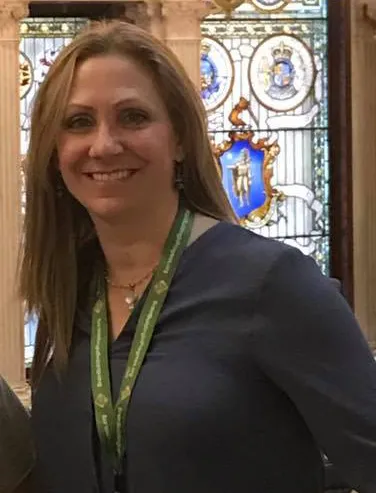
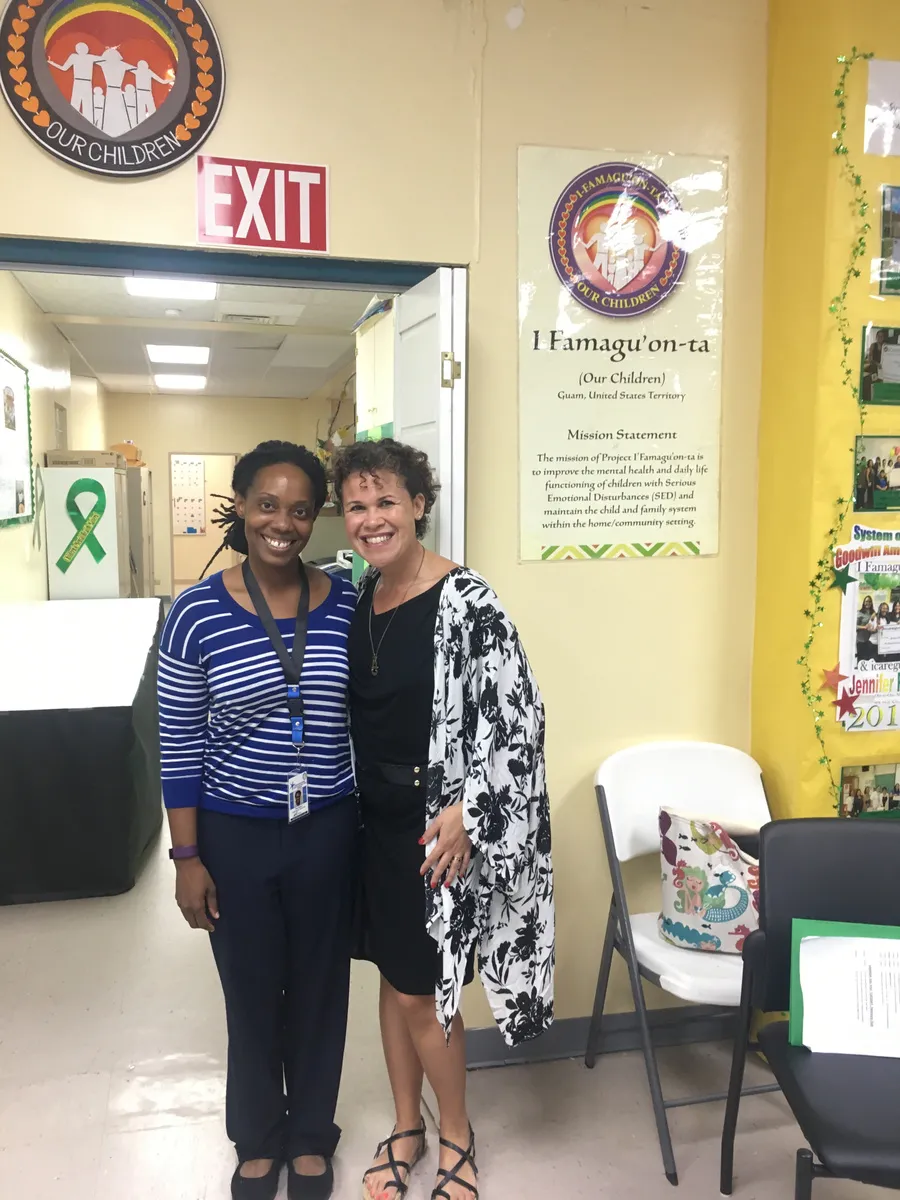
hafa adai
HAFA ADAI!: VISITING GUAM AND THE NORTHERN MARIANA ISLANDS AS A SAMHSA SITE VISIT COORDINATOR
By Professor Arabella Perez, LCSW
Hello, in Chamorro! I traveled to the future and am back to tell you all about it. Seriously, though, I crossed the international date line and visited Guam and the Commonwealth of the Northern Mariana Islands (CNMI) as a federal site visitor for the Substance Abuse Mental Health Service Administration’s (SAMHSA) Children’s Mental Health Initiative. I know, a mouthful, right! I’ve been fortunate to travel across the U.S. as a “content expert” and as a SAMHSA site visit coordinator, hearing from providers and community members about their experiences with mental health services. I’m coming up on 5 years of offering such consultation and I always come back better informed and a bit humbled by the work that other communities are doing with these grant dollars.
So, imagine my surprise and pleasure when I was contacted in the fall and asked if I would be the federal site coordinator for both Guam and CNMI. I knew that Guam and Puerto Rico were territories that had a SAMHSA cooperative agreement but did not know that CNMI (a US territory!) was recently awarded a grant to enhance and develop services offered on the islands of Saipan, Rota, and Tinian. Of course, I said yes and am here to tell you all about it.
First, it was a lot of work. I met with island mayors, senators, and legislators. I also met with state agencies and providers. And on the island of Guam, I got to meet one of our UNE SSW online students, Toni Lawson, who is doing her placement with Guam Behavioral Health. What a pleasant surprise to have her walk into a large stakeholder meeting full of legislators and the Director pauses to announce that Professor Perez must stop and take a photo with Toni. Smiles greeted us all around, pleased to know that we are a small world, after all. By the way, their federally funded initiative is called, I Famagua'on-ta (Our Children). Says it all, which is a great segue into the highlight of my travels, meeting with family and youth for community dinners each night. It’s an honor to be welcomed to a table and hear first hand from families and youth about their own personal stories. I think I’m actually a cultural anthropologist disguised as a social worker!
A little bit of history, the indigenous people on all the islands are Chamorro and are bilingual in their native tongue and English. It’s an actual mandate that they be taught in both languages. Many of the Chamorros have bloodlines that are mixed with those of their native Polynesian tribes, Spaniards, Filipinos, Chinese and Japanese. If you don’t realize already, these are islands that have a long history of colonization, occupation and forced enslavement.
While there I discovered that their language is influenced by Spanish, as is their food. You would see signs at the airport bidding you, “Adios” and every meal had their version of Spanish rice, empanadas and plantains. I felt like I was on my ancestral island of Puerto Rico and was often pleasantly mistaken for Chamorro, especially because Perez is a very common name on the island. I have rarely met a more inviting, resilient and engaging group of individuals. They fed me constantly and offered hugs with shell and seed leis at each reception. I have a collection that I plan to wear often.
The darker side of the island unfolded quickly as I heard story after story of historical, cultural and personal trauma. This is a U.S. territory that has relegated the indigenous people to a second-class status. During the nearly three years of occupation during WW2 by the Japanese, 1,170 Chamorros were killed, with another 14,721 suffering from atrocities of war — beatings, forced labor, torture, rape, murder, beheadings, massacres, forced marches and concentration camps
With limited resources and little to no voice in governance, these islands struggle with a complicated relationship involving paying reparations from WW 2 and accepting more of our military presence. If you don’t already know, Tinian is where the B-29 bombers that dropped the atomic bomb on Hiroshima and Nagasaki, took off. It’s also the site of mass suicides by Japanese civilians, which included children, who jumped from two cliffs to their death. A tragic end to the war.
Being trauma-informed on these islands meant that instead of being a content expert I was an observer and listener. I was fortunate that the federal SAMHSA Project Officer, a public health officer, is also a member of the Lumbee tribe of South Carolina. He approached the visit as he would a visit to one of the native tribes on the mainland. We graciously accepted and ate every meal (even if I had just eaten a large breakfast an hour ago), traveled on small 5 seater planes to visit communities (I get motion sick), learned a bit of the native language, attended street festivals and visited cultural sites. As I heard them describe services and supports it was evident that traditional mental health was not a culturally responsive model. And how could it be when two of the three Mariana Islands have only one therapist apiece and the last had no mental health therapist at all. Instead, the communities use a model called “natural helpers” taught to all school children and have trained more than 300 islanders in Mental Health First Aid. Because they have a federal grant they are trying to create a traditional mental health model and struggling with the nuts and bolts. At the end of the visit, I took one of the clinicians aside and told her that all this talk of evidence-based outpatient therapy was culturally stifling and unsustainable. Instead, what they had proudly described to us as teaching islanders to care for each other’s mental health and wellness was the best example of community evidence and the most sustainable.
So what did I hear from the families and youth? Pride of culture and language. The value of “Poksai”: raising each other’s children. The notion that we and our surroundings are all interconnected. A deep connection to the divine expressed through religious and cultural practices. And a love of island and home.
I thank the Chamorro people for sharing their islands with me and teaching me that culture matters above all else. It is one of the most important protective factors we have that binds us to our ancestors and our history. It may be the only thing you have left when services and supports disappear. Everyone has it and everyone can teach it. The Puerto Rican in me felt at home.
P.S. I ate bat soup. Yep, that happened. And no, it doesn’t taste like chicken.
LORI K. GRAMLICH, LMSW ('97), EXECUTIVE DIRECTOR OF NASW — MAINE CHAPTER
Column originally published in the NASW March '17 Newsletter
With our new administration in Washington offering their first piece of legislation, all eyes are on health care. Ultimately, it appears that more decision making authority, relative to health insurance coverage and namely, Medicaid, will go to individual states. As we know in the state of Maine, when the Affordable Care Act was introduced in 2010, Governor LePage opted not to participate in the exchange, so that more Mainers would not only have access to health insurance coverage, but so that more Mainers would be able to afford coverage. Currently there are approximately 60,000 Mainers who go without health care coverage because they simply are unable to afford to purchase it. If — and more pointedly when — these decisions get shifted to the state, I grow increasingly concerned about the folks who will not have health care — health care, which in my opinion, should be a basic right for all — not just something for those who can afford it. This speaks directly to our Code of Ethics and our advocacy for less fortunate populations.
Additional changes we see coming from Washington, which will have significant implications on Mainers, is the proposal to completely de-fund Planned Parenthood. This concern is not intended as a statement from me or our Chapter relative to the issues of pro or anti-choice — it is an issue related directly to health care. The administration in Washington, with its intent to essentially close Planned Parenthood, by way of completely eliminating Medicaid funding will mean Mainers who rely on these services for their wellness exams, cancer screenings, testing and treatment for sexually transmitted infections for women and men, will no longer be able to receive these services.
We further understand that the distribution of funds for Federal programs such as Medicaid and the Supplemental Nutrition Assistance Program, or SNAP block grant program will be distributed by means of block grants to the states. The Federal government would give a set amount of money to each state for Medicaid; it would be up to the states to spend it however they like.
Former Maine Department of Health and Human Services Commissioner, Kevin Concannon, who is currently the U.S. Department of Agriculture's undersecretary for food, nutrition and consumer services, believes there's good reason to worry over the possibility of block grants. Mr. Concannon’s concerns, like many in the state of Maine, is that if left up to our current administration in Maine, our vulnerable populations who rely on assistance, may potentially no longer be able to access assistance.
So what can we do? We as social workers have an ethical responsibility to work on these public policy initiatives. Many at times, feel overwhelmed with the complexity of these issues and often wonder where to start. We can consistently let our Congressional Delegation in Washington understand our position on these above referenced initiatives. We can also start in our Maine legislature. We have a number of priorities in this legislative session that social works can be involved in.
- LD 530 – An Act to Ensure Medical Assessment for Youth in Foster Care – Rep. Hamann
- LD 582 – An Act to Provide for the Comprehensive Assessment of Children Entering State Custody – Sen. Gratwick
- LD 912 – An Act to Clarify the Scope of Practice of Certain Licensed Professionals Regarding Conversion Therapy – Rep. Fecteau
We are also following the additional bills which have not been printed:
- LR 1498: An Act to Ensure Transparency in the Distribution of Federal Block Grant Funds — Rep. Jorgensen of Portland
- LR 1618: An Act to Ensure Access to Behavioral Health Services — Rep. Perry of Calais
- LR 1396: Resolve, To Establish a Moratorium on Rate Changes Related to Certain Community Mental Health Services — Rep. Gattine of Westbrook
- LR 1783: An Act to Support Substance Use Prevention, Treatment and Recovery – Rep. Beebe-Center of Rockland
- LR 1965: An Act to Restore Community Support Services for Adults with Mental Illness — Sen. Bellows of Kennebec.
We clearly have much work to do. In these times, it is more apparent than ever, that we need to have social workers engaged in advocacy efforts and in public policy to affect systemic change on behalf of our clients and for our profession.
EXPLORING SHARED SPACES AND FINDING A COMMON VOICE IN AN UNCOMMON TIME
by Professor Thomas McLaughlin and Student Support Specialist Meg Webster
Vaclav Havel is quoted saying “it is not enough to stare up the steps, we must step up the stairs.” We feel like there is plenty happening in our world that can seize us up. But we also think there is opportunity in finding commonality, wisdom and a sense of community.
But how do we really see one another? What makes us really listen to each other? Though we know the things that divide us are immensely layered and complex, we feel there is something very rudimentary and key to this notion of finding familiarity and intimacy within our diversity. And as Vaclav Havel so poignantly expresses — it’s not enough to simply stare, but let us engage…
To that end, we have been thinking about those spaces which all of us occupy. Maybe it’s a seat in a classroom which is shared by many different students throughout the day, maybe it’s the space in the checkout aisle of the grocery store where your curiosity about what the person in front of you will prepare with those potatoes they are purchasing. Shared space is something we think most of us take for granted. Stop and see that this shared space is filled with people who have gifts — gifts to share. Perhaps sometimes those gifts are simply a smile or even curious ensemble which invites the imagination to consider possibilities. It’s difficult to overlook or forget someone in the shadows when their story is known...felt. At a time when it really does feel the world could seize us up in one giant gulp, perhaps it’s the most opportune time to pause. To stop. To reflect on what exactly we are immersed in. We are among one another. The real heroes are sometimes not where we think they are, but right here among us in these spaces we share. But how do we talk and write about this?
This project, in itself emerged out of finding commonality. Both of us approached the Portland Phoenix independently — our ideas similar yet angles slightly different. Together we found a way to merge them into a shared voice to create these pieces. Through this collaboration, openness to ideas and conversation, not only have we found a way to share the space of the blank page, but we hope to bring these Portland faces to the forefront and accentuate our belonging — to shed light on the hidden gems of this beautiful, rich, diverse city in which we all live.
Stay tuned!
